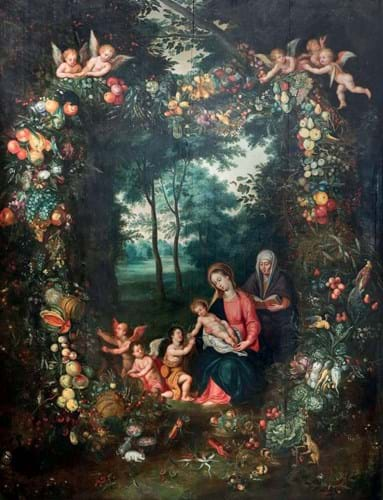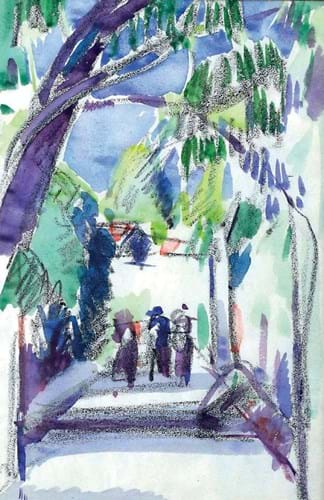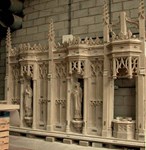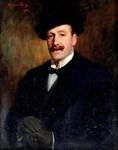
While the portable nature of jewellery, coins, collectables and books has meant that the supply of these goods has kept up much better in the lockdown than other sectors – especially those of bulkier goods such as furniture and sculpture – pictures have probably been somewhere in between.
Increasingly, fine art sales are running in an online-only format although, inevitably, the amount of activity in the market has been reduced over the last six weeks. The number of auctions taking place is well down on normal levels for this time of year.
The sales that did go ahead, however, may have been a bit thinner than usual but, in terms of interest and bidding, have generally not demonstrated the kind of drop-off in demand that may have been expected.
One thing we can report is that going into the lockdown some decent action was taking place in the art market around the country – a hopeful sign that some confidence may be retained as we come out the other side.
For example, Ewbank’s (25% buyer’s premium) anniversary sale in Woking, Surrey – marking the firm’s 30th year in business – raised close to £600,000 from 1660 lots on March 18-20.
The pictures were offered on the middle day and included the early coastal scene of Australia by Haughton Forrest (1826-1925) that took £6000 against hopes of £1000- 1500 (News, ATG No 2436).
The auction had 20 picture lots exceeding a hammer price of £1000.
Family source
Among the works selling considerably above predictions was a Flemish oil on panel of The Holy Family with the infant St John the Baptist. It was one of two works consigned for sale by the Nowell family, in whose possession it had been for more than 200 years.
The family’s ancestry can be traced back to Alexander Nowell (c.1507-1602), the Dean of St Paul’s Cathedral who, according to Thomas Fuller’s History of the Worthies of Britain (published in 1662), was credited with inventing bottled beer.
The painting had entered the family much later in 1816 when it was given to another Alexander Nowell by a friend for helping their son when he got into trouble in India.
The 4ft x 3ft 1in (1.21m x 93cm) oil on panel depicted the Holy Family surrounded by cherubs, birds, animals, fruit and vegetables with a landscape beyond and was catalogued as ‘Studio of Jan Brueghel the Younger (1601-78)’.
Works attributed to Jan Brueghel the Younger with figures encircled by exuberant garlands and swags of fruit and flowers are not unknown.
A similar example to the current work but with slight differences to the figures and foliage and fully ascribed to Jan Brueghel the Younger sold for £73,000 at Sotheby’s in July 2012.
The picture at Ewbank’s had an old handwritten label on the verso stating that the surrounding bower was painted by Brueghel and Hans Rottenhammer, a German painter who specialised in cabinet paintings on copper but who is also known to have collaborated with Jan Brueghel the Elder.
It was pitched at £4000-6000, a level that did not look excessive for a decent 17th century painting with an attractive subject and composition in any case.
With the good provenance also in its favour, the work drew strong competition and it was finally knocked down at £17,000, the top picture price of the day.
The other work from the same consignment, however, met a different fate.
A portrait of Alexander Nowell, Dean of St Paul’s, which was thought to date from either the 16th or 17th century but by an unknown hand, was unsold against the same £4000- 6000 estimate. It had undergone some restoration work which may have counted against it.
More to the eye
Also by an unknown artist but generating a better response, an intriguing figurative painting of two male figures and a woman holding spears came from a separate source.
The unsigned 2ft 11in (90cm) square oil on canvas was catalogued simply as ‘19th century’ and estimated at just £300-500.
However, housed in an attractive gilt frame and with an evidently baroque style and subject, it caught the eye of bidders who clearly felt it merited further attention.
It had some significant underlying qualities, such as the painterly execution, fleshy tones and compositional interplay of the figures, as well as the use of perspective to the landscape in the background. Bidders also presumably believed it had an earlier date.
The work was taken to £5200, a speculative buy perhaps but one that may pay off after further research.
Colourist sketchbook
Elsewhere at the sale, two bright watercolours by Scottish Colourist John Duncan Fergusson (1874-1961) were originally part of an artist’s sketchbook he had filled travelling around the south of France in the mid-1920s.
Both had been part of a group of six watercolours from sketchbooks that were dispersed at Sotheby’s in 1991 and they reappeared at Ewbank’s as separate lots with estimates of £2000-3000 each.
One of them was a sketch made in the town of Antibes on the French Riviera dating from 1925.
The 6¼x 4¼in (16 x 11cm) watercolour over black chalk depicted three figures walking along a promenade amid lush foliage and under an azure sky.
It was typical of the spontaneous and airy pictures that the artist produced on his regular visits to the southern French coast from the early 20th century onwards (he had produced plenty of landscapes mainly around Cassis, where he had settled before the First World War, for example). The watercolour was knocked down on top estimate to a Scottish buyer.
Even though figurative works by Fergusson tend to command higher prices, the £3000 sum still looked decent value for an artist who can fetch substantially more.
Another watercolour of Antibes fetched £17,000 at Sotheby’s in September last year although it was earlier, larger and had the presence of the sea and a small boat.
The second Fergusson sketch was Flowers, a watercolour of the same size which was also colourful and spontaneous but perhaps more loosely handled than some of his still-life oil paintings.
It sold on thesaleroom.com under estimate at £1700 to a buyer in Scotland.
















